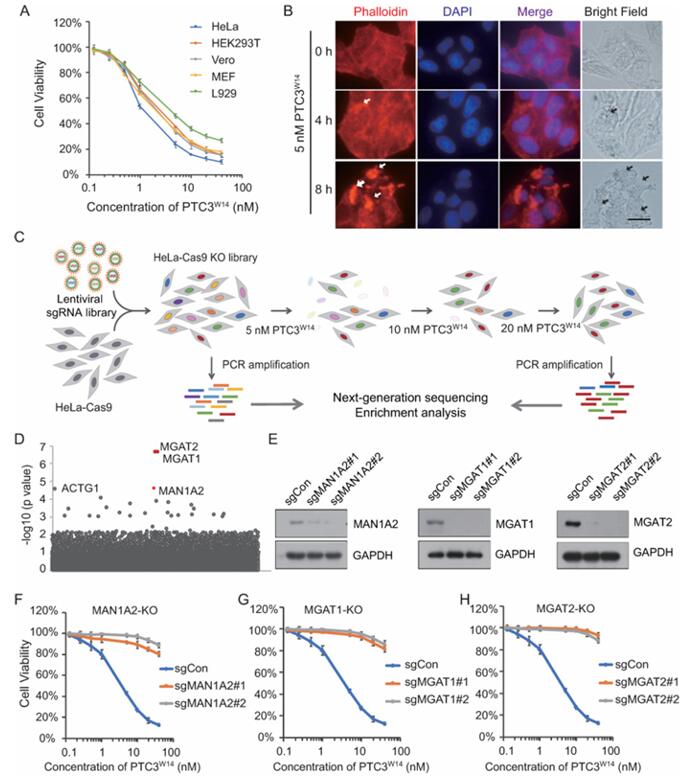Cas9 Stable Cell Line - HeLa
Cat.No. : CSC-RO0026 Host Cell: HeLa
Size: >1x10^6 cells/vial Validation: T7 Endonuclease I assay
Cat.No. : CSC-RO0026 Host Cell: HeLa
Size: >1x10^6 cells/vial Validation: T7 Endonuclease I assay
| Cat. No. | CSC-RO0026 |
| Product Type | Cas9 overexpression stable cell line |
| Introduction | Clustered regularly interspaced palindromic repeats (CRISPR)/Cas9 is a gene-editing technology that contains two essential components: a guide RNA (gRNA) to match a target gene, and the Cas9 (CRISPR-associated protein 9) endonuclease which causes a double-stranded DNA break, allowing modifications to the genome via nonhomologous end joining (NHEJ) or homology-directed repair (HDR). |
| Cell Line Information | HeLa-Cas9 cell line is engineered to stably overexpress Cas9 nuclease. The Cas9 nuclease in HeLa-Cas9 cell line has been functionally validated using T7 Endonuclease I assay. In combination with separately transfected sgRNAs, HeLa-Cas9 cell line can be used to efficiently generate targeted genomic modifications including gene knockout, gene knockin, gene mutagenesis, gene tagging etc. It is also an ideal cell line model for sgRNA screening and validation, either individually or in pools. |
| Target Gene | Cas9 |
| Host Cell | HeLa |
| Applications | 1) CRISPR genome editing, such as gene knockout (KO), gene knockin (KI), gene mutagenesis, gene tagging etc. 2) High-throughput sgRNA screening and validation |
| Quality Control | 1) T7E1 assay 2) Mycoplasma detection |
| Size Form | One vial of frozen cells, typically >1x10^6 cells/vial |
| Shipping | Dry ice |
| Storage | Liquid nitrogen |
| Species | Homo sapiens (Human) |
| Mycoplasma | Negative |
| Format | One frozen vial containing millions of cells |
| Storage | Liquid nitrogen |
| Safety Considerations |
The following safety precautions should be observed. 1. Use pipette aids to prevent ingestion and keep aerosols down to a minimum. 2. No eating, drinking or smoking while handling the stable line. 3. Wash hands after handling the stable line and before leaving the lab. 4. Decontaminate work surface with disinfectant or 70% ethanol before and after working with stable cells. 5. All waste should be considered hazardous. 6. Dispose of all liquid waste after each experiment and treat with bleach. |
| Ship | Dry ice |
The researchers explored the mechanism of Tc toxin recognition and cellular intoxication, focusing on how specific glycan receptors, such as N-glycans and sulfated glycosaminoglycans (sGAGs), mediate the binding of different Tc toxins. The researchers performed two independent genome-wide CRISPR-Cas9 screens using HeLa cells to identify genes involved in toxin sensitivity. Their findings revealed that the knockout of N-glycan processing enzymes blocked TcdA1W14 toxicity, while sulfation in sGAGs was critical for the binding of TcdA2TT01. This work provides new insights into the host-specific interactions of Tc toxins, which could lead to more targeted biomedical applications. To perform these CRISPR screens, the researchers utilized HeLa cells stably expressing Cas9 (HeLa-Cas9), which were transduced with a lentiviral single guide RNA (sgRNA) library targeting over 19,000 human genes.
 Figure 1. The researchers used HeLa-Cas9 cells to perform a genome-wide CRISPR-Cas9 screen, identifying genes involved in PTC3W14 toxin sensitivity. They treated these cells with various concentrations of PTC3W14 and assessed cell viability, actin polymerization, and membrane blebbing to identify critical host factors. (Song N, et al., 2021)
Figure 1. The researchers used HeLa-Cas9 cells to perform a genome-wide CRISPR-Cas9 screen, identifying genes involved in PTC3W14 toxin sensitivity. They treated these cells with various concentrations of PTC3W14 and assessed cell viability, actin polymerization, and membrane blebbing to identify critical host factors. (Song N, et al., 2021)
Creative Biogene's Cas9 Stable Cell Line - HeLa is ideal for similar genetic screening applications, offering a reliable platform for gene knockout studies and advanced toxin receptor research.

Our promise to you:
Guaranteed product quality, expert customer support.
 24x7 CUSTOMER SERVICE
24x7 CUSTOMER SERVICE
 CONTACT US TO ORDER
CONTACT US TO ORDER